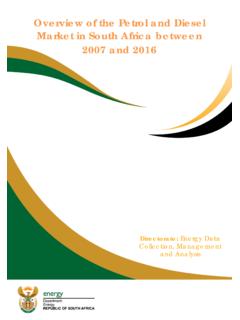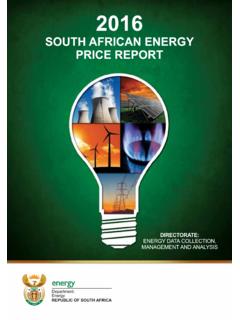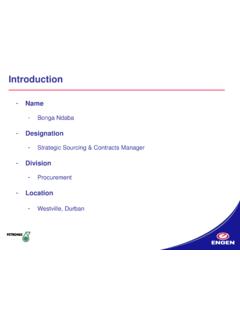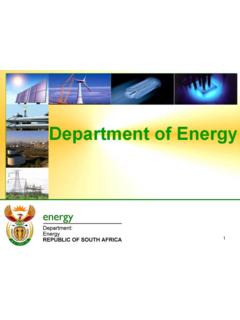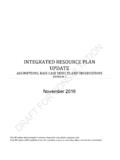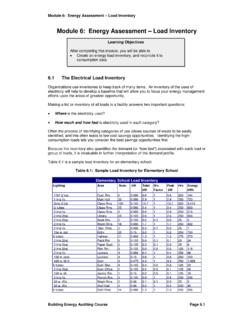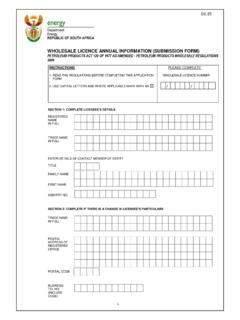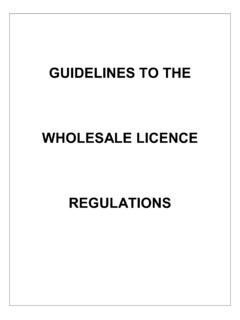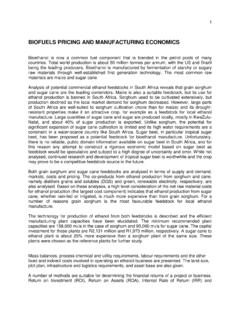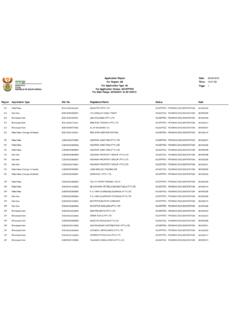Transcription of Biofuels Industrial Strategy of the Republic of South ...
1 Biofuels Industrial Strategy of the Republic of South africa Department of Minerals and Energy December 2007. Table of Contents Pages 1 Executive Summary .. 3. 1 Introduction .. 5. Purpose ---------------------------------------- ---------------------------------------- ----------------- 5. Background ---------------------------------------- ---------------------------------------- ------------ 5. 2 Objectives of this 8. 3 Feasibility Study 9. 4 Current Situation .. 10. 5 International Situation .. 11. 6 Issues Involved .. 12. Agriculture ---------------------------------------- ---------------------------------------- ----------- 13. Food Security ---------------------------------------- ---------------------------------------- ------- 14. Animal Feed------------------------------------ ---------------------------------------- -------------- 15.
2 Land issues ---------------------------------------- ---------------------------------------- ---------- 15. Water Resources ---------------------------------------- ---------------------------------------- --- 16. Biofuels Production Plants ---------------------------------------- ----------------------------- 17. Fuel Industry-------------------------------- ---------------------------------------- ----------------- 17. Biofuels contracts ---------------------------------------- ---------------------------------------- - 18. Mandating Biofuels Uptake ---------------------------------------- ----------------------------- 19. Integration ---------------------------------------- ---------------------------------------- ----------- 20. 7 The Strategy .. 20. 8 Specific Interventions .. 21. Licensing of Producers ---------------------------------------- ---------------------------------- 21.
3 Off-take by Petroleum Wholesalers Based on Discounting ------------------------- 22. Biofuels Industrial Strategy 1 of 29. December 2007. Fuel Levy Exemption ---------------------------------------- ------------------------------------- 22. Agricultural Support ---------------------------------------- -------------------------------------- 23. Capacity Building and Development ---------------------------------------- ---------------- 23. Government Agencies-------------------------------- ---------------------------------------- ---- 23. 9 24. SADC Integration----------------------------- ---------------------------------------- -------------- 24. Future Research and Development ---------------------------------------- ------------------ 25. 10 Implementation Plans .. 25. Communication and Education ---------------------------------------- ----------------------- 26.
4 Monitoring and Evaluation------------------------------ ---------------------------------------- 26. The Way Forward ---------------------------------------- ---------------------------------------- -- 26. Biofuels Industrial Strategy 2 of 29. December 2007. Biofuels Industrial Strategy . 1 Executive Summary This document presents the proposed South African Biofuels Industrial Strategy and outlines Government's approach to policy, regulations and incentives. This is a refinement of the draft Strategy approved by Cabinet for public comments in December 2006. The changes are based on comments received from a wide range of stakeholders. The stakeholders' comments covered areas such as water limitations, food security (availability and affordability), land prices and land restitution, environmental concerns, Biofuels quality, technology choices, crop selection/choices, support and incentives and concerns that Strategy /policy is taking too long to be finalized.
5 The draft Strategy was developed by the Biofuels Task Team appointed by Cabinet in December 2005 with a mandate to develop a national Biofuels Industrial Strategy targeted at creating jobs in the energy-crop and Biofuels value chain, and to act as a bridge between the first and second economy. A significant change to the draft Strategy is to adopt a short term focus (5 year pilot) to achieve a 2% penetration level of Biofuels in the national liquid fuel supply, or 400 million litres pa. The target has been revised down from the target that was initially proposed in the draft Strategy document. The following crops are proposed for the production of Biofuels in the country: for Bioethanol, sugar cane and sugar beet and for Biodiesel sunflower, canola and soya beans. The exclusion of other crops and plants such as maize and Jatropha is based on the food security concerns.
6 Further research is still needed to test usability of these in the country. The 2% level can be achieved without jeopardising food security. The Strategy targets new and additional land and proposes that basic food crops be excluded in the initial stages. This will require about of arable land in South africa . Currently 14% of arable land, mainly in the former homelands, is under utilised. The producer (investor) incentive should only be allocated to projects that involve expansion that assist in achieving the 2% target. This will ensure job Biofuels Industrial Strategy 3 of 29. December 2007. creation, expanded agricultural production, and increased food supply. In the case of extreme drought and crop failures, a certain percentage of feedstock on the additional agricultural land may be redirected to the food market to address shortages.
7 In terms of the first and second economy trajectory, government will have to support the development of the under utilised land to a level that will compete commercially. Farmers located in underdeveloped land will be encouraged through cooperatives (where possible) to participate in the running of Biofuels refineries. The existing fuel levy exemption, for biodiesel that is a product (as opposed to producer). incentive should continue. Biodiesel currently enjoys a 40% fuel levy exemption. It is proposed that once the Strategy is approved, this levy exemption be increased to 50% from the 2008/9. financial year. Thereafter the percentage will remain the same but the absolute value of the support will increase with increases in the fuel levy. It is impractical to increase the exemption beyond 50% due to the impact of the current diesel tax refund scheme.
8 A 100% fuel tax exemption is proposed for bioethanol as it can also be used in markets other than petrol ethanol gel that competes with illuminating paraffin. Illuminating paraffin carries no levies. The producer support mechanism will be used to balance the difference in fuel tax support to bioethanol and biodiesel by setting a fixed margin price. A 100% petrol tax exemption amounts to an effective support of per litre, whereas a 50% diesel fuel levy exemption amounts to an effective support of per litre. The support to bioethanol as a product is thus 68 cents per litre higher than diesel. The proposed support during the initial stages should assist investors to achieve a reasonable return on investments. To reduce project risk related to feedstock provision, further support to the farmers and particularly communities living on the under utilised land, will be needed.
9 This can be done through existing agricultural support programmes as well as from support of investments made by the project in agricultural development. Biofuels Industrial Strategy 4 of 29. December 2007. 1 Introduction Purpose Internationally, the growth of the Biofuels industry has been driven by a number of factors which includes: the support for renewable energy, support for cleaner and environmentally friendly energy sources in a bid to limit global warming; upliftment of the agricultural sector (through utilisation of surplus agricultural land to produce products in excess of food needs);. promotion of sustainable development, exertion of downward pressure on global crude oil prices and the need to improve energy security. The Biofuels programme has the potential to uplift agricultural sectors and to unlock substantial economic benefits in sub-Saharan africa , South America and other developing regions, in particular by: o Attracting investment into rural areas.
10 O Promoting agricultural development;. o Import substitution of foreign oil with balance of payment savings; and o Overcoming the trade distorting effects that South africa , African subcontinent and other developing countries have faced overtime because of subsidised agricultural production in developed countries. In South africa , a specific requirement of the Biofuels Industrial Strategy was to create a link between the first and second economies. This requirement entailed creating jobs in under- developed areas, such as in the former homelands, where agriculture was undermined by the apartheid system. Clear government policy regulations and incentives are a pre-requisite for the development of the Biofuels industry. This is particularly due to the volatile nature of oil product prices with which Biofuels must compete; this is a similar scenario to that experienced by South africa during the development of the synthetic fuel industry.
